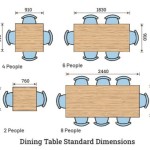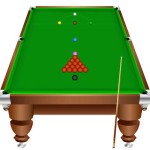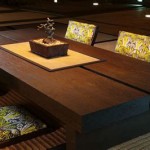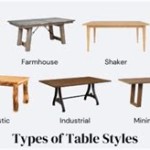Japanese Tables and Chairs: A Harmony of Tradition and Functionality
Japanese tables and chairs represent more than mere furniture; they embody a cultural philosophy rooted in minimalism, harmony, and a deep appreciation for natural materials. Understanding the design principles and historical context behind these pieces offers valuable insight into Japanese aesthetics and lifestyle. This article delves into the characteristics, types, and cultural significance of Japanese tables and chairs, examining how they have evolved and continue to influence contemporary design.
The evolution of Japanese furniture is inextricably linked to the changing lifestyles and architectural styles of Japan. Historically, traditional Japanese homes featured tatami mats, woven straw flooring, which influenced a ground-level living approach. Furniture, therefore, was designed to be low to the ground, fostering a sense of closeness and connection with the natural world. This is evident in the traditional *zabuton* cushions and low tables that characterized early Japanese interiors.
The introduction of Western design in the Meiji era (1868-1912) marked a significant turning point. As Japan opened its doors to global influences, Western-style chairs and tables began to appear in homes, offices, and public spaces. However, rather than replacing traditional designs entirely, Western furniture was often adapted and integrated into Japanese interiors, creating a unique fusion of styles. This fusion continues to influence modern Japanese furniture design, resulting in pieces that blend the functionality and comfort of Western furniture with the aesthetic principles of Japanese tradition.
Key Point 1: Characteristics of Traditional Japanese Tables
Traditional Japanese tables, often called *chabudai* or *kotatsu*, are typically low to the ground and designed for use while sitting on tatami mats or cushions. The *chabudai* is a versatile low table often used for dining, working, or relaxing. Its simplicity and portability are defining features. Typically made of wood, frequently lightweight cedar or paulownia, allowing for easy movement and storage. Many *chabudai* feature folding legs, facilitating convenient storage when not in use.
The *kotatsu*, on the other hand, is a heated table that serves as a central gathering point during the colder months. It consists of a low wooden table frame covered by a futon (a heavy quilt), with a heating element placed underneath. People sit around the *kotatsu*, tucking their legs under the futon for warmth. The *kotatsu* transcends mere functionality; it fosters a sense of community and warmth, providing a focal point for social interaction and relaxation during the winter season.
The choice of wood is paramount in traditional Japanese table construction. Woods like cedar, paulownia, and cypress are favored for their natural beauty, durability, and resistance to moisture. These woods are often finished with natural lacquers or oil-based treatments to enhance their grain and protect them from wear and tear. The attention to detail in the selection and finishing of materials reflects a deep respect for the natural world.
Design elements often include clean lines, minimalist forms, and an emphasis on practicality. Ornamentation is typically subtle, focusing on the inherent beauty of the wood grain and the craftsmanship of the joinery. The aim is to create a harmonious and uncluttered space, promoting a sense of calm and tranquility. The focus is not on elaborate decoration, but rather on the purity of form and the functionality of the design.
Key Point 2: Examining Different Types of Japanese Chairs
While floor seating has been a long-standing tradition in Japan, chairs have become increasingly prevalent, particularly in modern homes and offices. Japanese chair design often takes inspiration from both traditional and Western styles, resulting in a diverse range of seating options. One common traditional type is the *zaisu*, a backrest chair without legs, designed for use on tatami mats. The *zaisu* provides back support while maintaining a low profile, preserving the traditional seating posture.
Modern Japanese chairs often incorporate ergonomic designs to promote comfort and support. These chairs may feature adjustable features such as lumbar support, seat height, and armrests. The use of breathable materials like mesh and natural fabrics is common to enhance comfort and prevent overheating. The focus is on creating chairs that are both aesthetically pleasing and ergonomically sound.
The *engawa* bench, traditionally placed along the veranda of a Japanese house, provides seating for enjoying the garden and the surrounding scenery. These benches are typically made of wood and feature simple, elegant designs. They offer a comfortable and inviting space for relaxation and contemplation.
Another type of chair is the *tatami-style* chair, which is designed to complement tatami mat flooring. These chairs often have a low profile and a solid wood frame, with a seat made of woven material or fabric. They blend seamlessly with the natural textures and colors of tatami mats, creating a cohesive and harmonious living space.
Folding chairs, often crafted from bamboo or lightweight wood, are also common. Their portability and space-saving design make them ideal for small apartments and outdoor events. They embody the Japanese emphasis on practicality and efficient use of space. Their simple and elegant designs reflect the minimalist aesthetic that characterizes much of Japanese design.
Key Point 3: Cultural Significance and Modern Adaptations
Japanese tables and chairs hold deep cultural significance, reflecting values such as respect for nature, simplicity, and harmony. The low seating arrangements encourage a sense of intimacy and connection, fostering closer social interactions. The use of natural materials like wood and bamboo connects people with the natural world, promoting a sense of tranquility and well-being.
In modern Japanese homes, a blend of traditional and contemporary styles is common. Many families still incorporate traditional elements such as tatami mats and *chabudai* into their living spaces, while also incorporating modern chairs and tables for added comfort and functionality. This blending of styles reflects a respect for tradition while embracing the conveniences of modern living.
Japanese furniture design has also had a significant influence on Western design. The minimalist aesthetic, the emphasis on natural materials, and the focus on functionality have all been adopted and adapted by Western designers. The clean lines, simple forms, and natural finishes of Japanese furniture have become increasingly popular in contemporary interiors around the world.
The concept of *wabi-sabi*, which embraces imperfection and impermanence, is also reflected in Japanese furniture design. This aesthetic values the natural aging process of materials and the unique character of each piece. Imperfections such as knots, cracks, and variations in wood grain are seen as part of the beauty of the object.
The future of Japanese table and chair design will likely continue to be shaped by a blend of tradition and innovation. Designers are constantly exploring new materials, techniques, and forms, while remaining true to the core principles of Japanese aesthetics. The emphasis on sustainability and environmental consciousness is also likely to play an increasingly important role in the design and production of Japanese furniture, ensuring that these pieces continue to embody the values of respect for nature and harmony with the environment.
The enduring appeal of Japanese tables and chairs lies in their ability to create spaces that are both functional and aesthetically pleasing. By combining traditional craftsmanship with modern design principles, these pieces offer a unique blend of beauty, comfort, and cultural significance, enriching the lives of those who use them.

5pcs Modern Japanese Style Floor Low Dining Table And Chair Set Fruugo Jp

5pcs Modern Japanese Style Floor Low Dining Table And Chair Set Fruugo Jp

Floor Furnitures Japan Style Dining Room Tables Chairs Seating Table Furniture Makeover

Buy Solid Wood Japanese Style Low Dining Table With Breakfast Set In Latest Sets Collection Saraf Furniture

Buy Solid Wood Japanese Style Low Dining Table With Breakfast Set In Latest Sets Collection Saraf Furniture

Japanese Style Living Room Furniture Sofa Set

Japanese Tables Tea Zen My Home

Modern Interpretations Of Legless Japanese Chairs Designs Ideas On Dornob

Daiki Japanese Dining Table And Chairs Urban Mood

Zataku And Zaisu Table Chairs In Japanese Style Best Home News Аll About Interior Design Architecture Furniture Landscape Decorating








